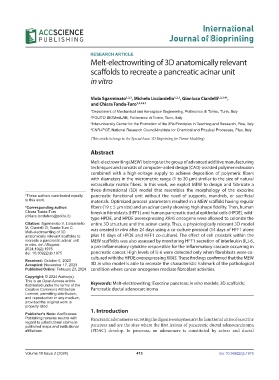Page 421 - IJB-10-2
P. 421
International
Journal of Bioprinting
RESEARCH ARTICLE
Melt-electrowriting of 3D anatomically relevant
scaffolds to recreate a pancreatic acinar unit
in vitro
Viola Sgarminato 1,2,3 , Michela Licciardello 1,2,3 , Gianluca Ciardelli 1,2,3,4† ,
and Chiara Tonda-Turo 1,2,3 †
*
1 Department of Mechanical and Aerospace Engineering, Politecnico di Torino, Turin, Italy
2 POLITO BIOMedLAB, Politecnico di Torino, Turin, Italy
3 Interuniversity Center for the Promotion of the 3Rs Principles in Teaching and Research, Pisa, Italy
4 CNR-IPCF, National Research Council-Institute for Chemical and Physical Processes, Pisa, Italy
(This article belongs to the Special Issue: 3D Bioprinting for Tumor Modeling)
Abstract
Melt-electrowriting (MEW) belongs to the group of advanced additive manufacturing
techniques and consists of computer-aided design (CAD)-assisted polymer extrusion
combined with a high-voltage supply to achieve deposition of polymeric fibers
with diameters in the micrometric range (1 to 20 µm) similar to the size of natural
extracellular matrix fibers. In this work, we exploit MEW to design and fabricate a
three-dimensional (3D) model that resembles the morphology of the exocrine
† These authors contributed equally pancreatic functional unit without the need of supports, mandrels, or sacrificial
to this work. materials. Optimized process parameters resulted in a MEW scaffold having regular
*Corresponding author: fibers (19 ± 5 µm size) and an acinar cavity showing high shape fidelity. Then, human
Chiara Tonda-Turo foreskin fibroblasts (HFF1) and human pancreatic ductal epithelial cells (HPDE), wild-
(chiara.tondaturo@polito.it)
type HPDE, and HPDE overexpressing KRAS oncogene were allowed to colonize the
Citation: Sgarminato V, Licciardello entire 3D structure and the acinar cavity. Thus, a physiologically relevant 3D model
M, Ciardelli G, Tonda-Turo C. was created in vitro after 24 days using a co-culture protocol (14 days of HFF1 alone
Melt-electrowriting of 3D
anatomically relevant scaffolds to plus 10 days of HPDE and HFF1 co-culture). The effect of cell crosstalk within the
recreate a pancreatic acinar unit MEW scaffolds was also assessed by monitoring HFF1 secretion of interleukin (IL)-6,
in vitro. Int J Bioprint. a pro-inflammatory cytokine responsible for the inflammatory cascade occurring in
2024;10(2):1975.
doi: 10.36922/ijb.1975 pancreatic cancer. High levels of IL-6 were detected only when fibroblasts were co-
cultured with the HPDE overexpressing KRAS. These findings confirmed that the MEW
Received: October 6, 2023
Accepted: November 17, 2023 3D in vitro model is able to recreate the characteristic hallmark of the pathological
Published Online: February 23, 2024 condition where cancer oncogenes mediate fibroblast activities.
Copyright: © 2024 Author(s).
This is an Open Access article Keywords: Melt-electrowriting; Exocrine pancreas; In vitro models; 3D scaffolds;
distributed under the terms of the
Creative Commons Attribution Pancreatic ductal adenocarcinoma
License, permitting distribution,
and reproduction in any medium,
provided the original work is
properly cited.
1. Introduction
Publisher’s Note: AccScience
Publishing remains neutral with Pancreatic adenomeres secreting the digestive enzymes are the functional units of exocrine
regard to jurisdictional claims in
published maps and institutional pancreas and are the sites where the first lesions of pancreatic ductal adenocarcinoma
affiliations. (PDAC) develop. In pancreas, an adenomere is constituted by acinar and ductal
Volume 10 Issue 2 (2024) 413 doi: 10.36922/ijb.1975

